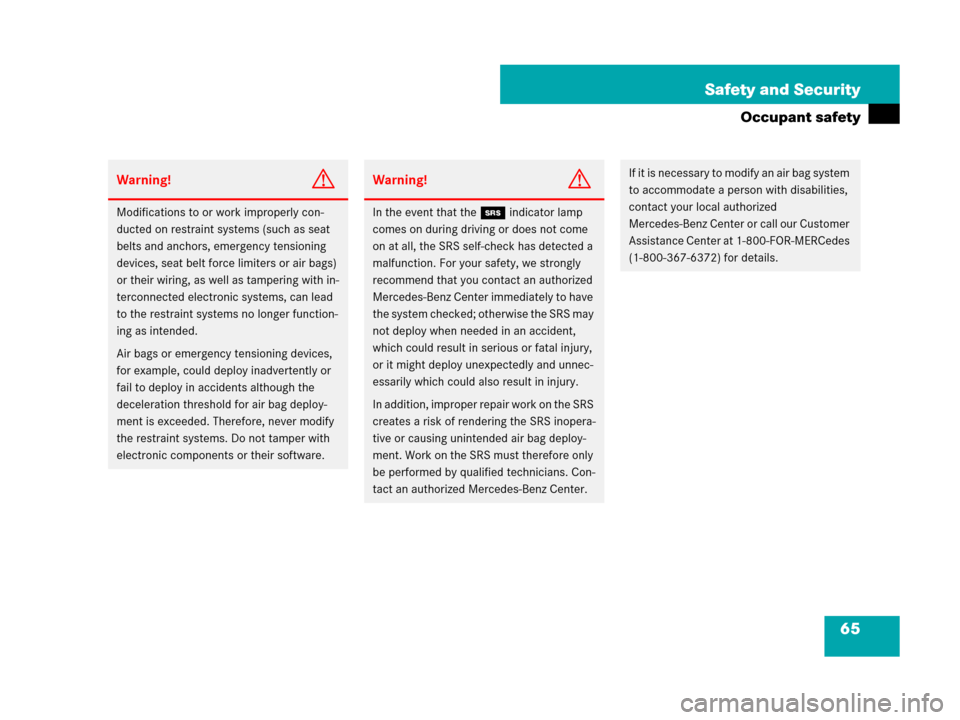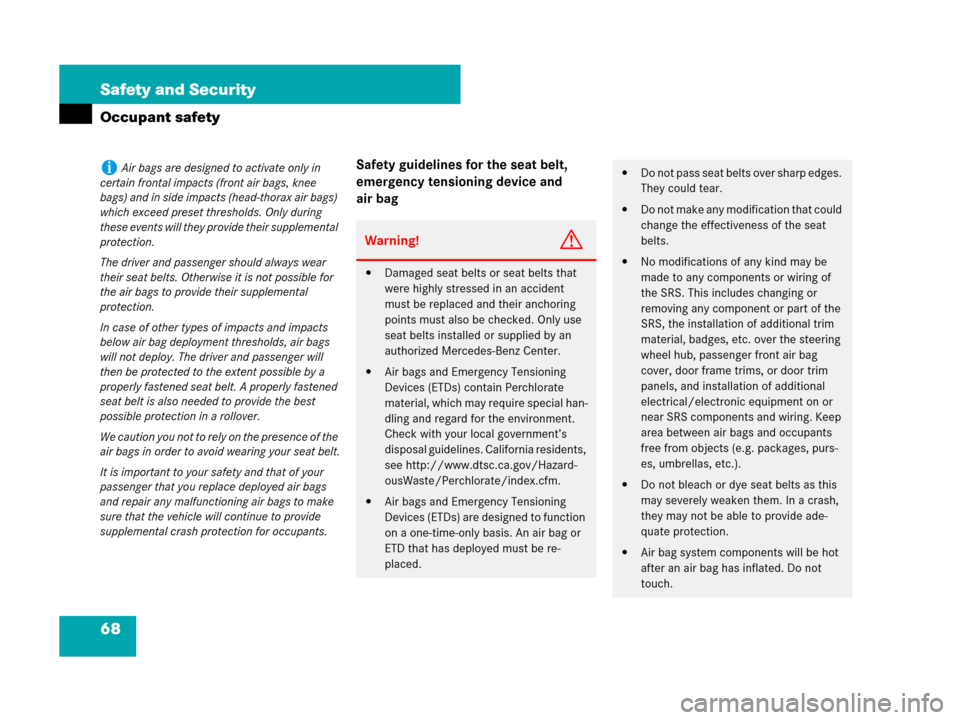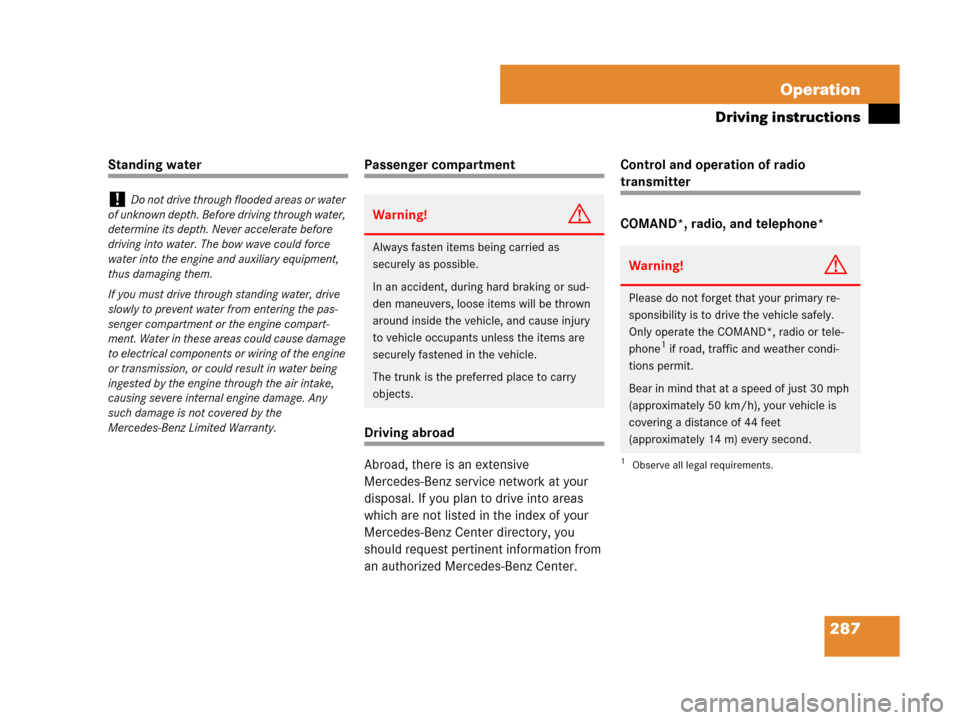Page 66 of 474

65 Safety and Security
Occupant safety
Warning!G
Modifications to or work improperly con-
ducted on restraint systems (such as seat
belts and anchors, emergency tensioning
devices, seat belt force limiters or air bags)
or their wiring, as well as tampering with in-
terconnected electronic systems, can lead
to the restraint systems no longer function-
ing as intended.
Air bags or emergency tensioning devices,
for example, could deploy inadvertently or
fail to deploy in accidents although the
deceleration threshold for air bag deploy-
ment is exceeded. Therefore, never modify
the restraint systems. Do not tamper with
electronic components or their software.
Warning!G
In the event that the 1 indicator lamp
comes on during driving or does not come
on at all, the SRS self-check has detected a
malfunction. For your safety, we strongly
recommend that you contact an authorized
Mercedes-Benz Center immediately to have
the system checked; otherwise the SRS may
not deploy when needed in an accident,
which could result in serious or fatal injury,
or it might deploy unexpectedly and unnec-
essarily which could also result in injury.
In addition, improper repair work on the SRS
creates a risk of rendering the SRS inopera-
tive or causing unintended air bag deploy-
ment. Work on the SRS must therefore only
be performed by qualified technicians. Con-
tact an authorized Mercedes-Benz Center.
If it is necessary to modify an air bag system
to accommodate a person with disabilities,
contact your local authorized
Mercedes-Benz Center or call our Customer
Assistance Center at 1-800-FOR-MERCedes
(1-800-367-6372) for details.
Page 69 of 474

68 Safety and Security
Occupant safety
Safety guidelines for the seat belt,
emergency tensioning device and
air bagiAir bags are designed to activate only in
certain frontal impacts (front air bags, knee
bags) and in side impacts (head-thorax air bags)
which exceed preset thresholds. Only during
these events will they provide their supplemental
protection.
The driver and passenger should always wear
their seat belts. Otherwise it is not possible for
the air bags to provide their supplemental
protection.
In case of other types of impacts and impacts
below air bag deployment thresholds, air bags
will not deploy. The driver and passenger will
then be protected to the extent possible by a
properly fastened seat belt. A properly fastened
seat belt is also needed to provide the best
possible protection in a rollover.
We caution you not to rely on the presence of the
air bags in order to avoid wearing your seat belt.
It is important to your safety and that of your
passenger that you replace deployed air bags
and repair any malfunctioning air bags to make
sure that the vehicle will continue to provide
supplemental crash protection for occupants.
Warning!G
�Damaged seat belts or seat belts that
were highly stressed in an accident
must be replaced and their anchoring
points must also be checked. Only use
seat belts installed or supplied by an
authorized Mercedes-Benz Center.
�Air bags and Emergency Tensioning
Devices (ETDs) contain Perchlorate
material, which may require special han-
dling and regard for the environment.
Check with your local government’s
disposal guidelines. California residents,
see http://www.dtsc.ca.gov/Hazard-
ousWaste/Perchlorate/index.cfm.
�Air bags and Emergency Tensioning
Devices (ETDs) are designed to function
on a one-time-only basis. An air bag or
ETD that has deployed must be re-
placed.
�Do not pass seat belts over sharp edges.
They could tear.
�Do not make any modification that could
change the effectiveness of the seat
belts.
�No modifications of any kind may be
made to any components or wiring of
the SRS. This includes changing or
removing any component or part of the
SRS, the installation of additional trim
material, badges, etc. over the steering
wheel hub, passenger front air bag
cover, door frame trims, or door trim
panels, and installation of additional
electrical/electronic equipment on or
near SRS components and wiring. Keep
area between air bags and occupants
free from objects (e.g. packages, purs-
es, umbrellas, etc.).
�Do not bleach or dye seat belts as this
may severely weaken them. In a crash,
they may not be able to provide ade-
quate protection.
�Air bag system components will be hot
after an air bag has inflated. Do not
touch.
Page 288 of 474

287 Operation
Driving instructions
Standing waterPassenger compartment
Driving abroad
Abroad, there is an extensive
Mercedes-Benz service network at your
disposal. If you plan to drive into areas
which are not listed in the index of your
Mercedes-Benz Center directory, you
should request pertinent information from
an authorized Mercedes-Benz Center.Control and operation of radio
transmitter
COMAND*, radio, and telephone*
!Do not drive through flooded areas or water
of unknown depth. Before driving through water,
determine its depth. Never accelerate before
driving into water. The bow wave could force
water into the engine and auxiliary equipment,
thus damaging them.
If you must drive through standing water, drive
slowly to prevent water from entering the pas-
senger compartment or the engine compart-
ment. Water in these areas could cause damage
to electrical components or wiring of the engine
or transmission, or could result in water being
ingested by the engine through the air intake,
causing severe internal engine damage. Any
such damage is not covered by the
Mercedes-Benz Limited Warranty.
Warning!G
Always fasten items being carried as
securely as possible.
In an accident, during hard braking or sud-
den maneuvers, loose items will be thrown
around inside the vehicle, and cause injury
to vehicle occupants unless the items are
securely fastened in the vehicle.
The trunk is the preferred place to carry
objects.
Warning!G
Please do not forget that your primary re-
sponsibility is to drive the vehicle safely.
Only operate the COMAND*, radio or tele-
phone
1 if road, traffic and weather condi-
tions permit.
Bear in mind that at a speed of just 30 mph
(approximately 50 km/h), your vehicle is
covering a distance of 44 feet
(approximately 14 m) every second.
1Observe all legal requirements.